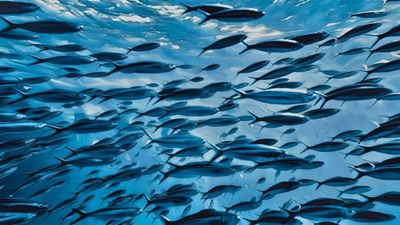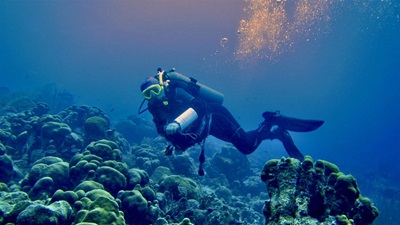Four Ways to Deter Illegal, Unreported and Unregulated Fishing in the Western and Central Pacific Ocean
Countries must commit to sustainable fisheries management by adopting stronger rules and requiring greater transparency

More than $21 billion in tuna is caught each year in the vast waters of the western and central Pacific Ocean.
The health of these fisheries and the welfare, safety and prosperity of rule-abiding fishers in the region are threatened by illegal, unreported and unregulated (IUU) fishing. A “crime of convergence,” IUU fishing is often linked with human and arms trafficking, money laundering, labor and human rights violations, fraud and more.
In early December, member nations of the Western and Central Pacific Fisheries Commission (WCPFC) will convene in Manila, Philippines, for the group’s annual meeting. Established in 2004, the regional fisheries management organization (RFMO) is tasked with conserving and managing tuna and other highly migratory fish stocks for that swath of the Pacific Ocean.
The Commission has the opportunity to take concrete action to limit IUU fishing in the region, protecting fisheries and the sustainability of vital marine resources.
Here are four steps they can take.
1. Improve independent monitoring of longline vessels
Thousands of commercial longline vessels traverse the western and central Pacific Ocean each year, setting baited hooks attached to lines that stretch for miles across the water. But WCPFC requires only 5 per cent observer coverage on these vessels – despite a 100 per cent requirement on vessels fishing with purse seine, the other commonly used fishing gear. Independent monitoring is critical to ensuring that vessels are following WCPFC rules while also supporting scientific data collection, but 5 per cent is far too low to detect and deter IUU fishing or to provide adequate data.
Electronic monitoring uses cameras and sensors to record fishing activity and is an effective and cost-efficient way to increase that coverage. In 2024, the WCPFC adopted electronic monitoring standards, paving the way for wider use of the technology on vessels in its waters. It’s time for Commission members to agree to raise observer coverage requirements for longline vessels to at least the scientifically recommended level of 20 per cent.
2. Require minimum standards for Port State Measures
Port State Measures (PSMs) are international regulations designed to prevent IUU fishing by denying vessels suspected of illegal activity access to ports. Effective PSMs stop IUU fishers from getting their catch to market by strengthening inspections and controls at a key point in the supply chain. Although WCPFC has minimum standards for PSMs in place, they have not been updated since 2017 and they are non-binding.
To date, only 10 out of 34 Commission members and cooperating non-members have opted in. Yet more than double that number – 23 – have signed onto the Port State Measures Agreement (PSMA), a binding international treaty to eliminate IUU fishing via strong port oversight that sets a much higher bar for PSMs. This means that not only should all 23 countries have implemented WCPFC’s minimum standards, but they should also hold themselves to the higher standard set by the PSMA within all of their fisheries, including those in WCPFC waters.
Commission members must work together to make the WCPFC’s existing rules on PSMs binding. They must also support developing States’ implementation efforts through a fund to align WCPFC’s requirements with the PSMA’s robust standards.
This will ensure that Pacific ports are not vulnerabilities through which illegal products can enter the supply chain.
3. Require transparency from commercial fishing owners
The people and companies profiting from illegal activities on the water are often obscured by complex corporate and ownership chains – parent companies and subsidiaries – that hide the “ultimate beneficial owner,” or UBO. This opaqueness means that the people controlling and profiting from these activities may never be identified or held to account, while those that conduct the activities out on the water suffer the consequences. However, WCPFC can effectively disincentivize a significant avenue for IUU activities by making access to fishing in its management area contingent on shared UBO information.
4. Update outdated transshipment measure without delay
Many WCPFC fisheries rely on transshipment, which is the transfer of catch from a fishing vessel to a carrier vessel at sea or in port. In fact, nearly 1 million metric tons of fish, worth $6.5 billion, are transshipped in the western and central Pacific Ocean each year – more than any other region in the world. When poorly regulated, high-seas transshipment can be used as a vehicle to launder illegally caught fish at sea, so strong oversight of this activity is a critical step in combatting IUU fishing.
Despite this, the Commission has not updated its transshipment measure for more than 15 years.
In 2022, the United Nations Food and Agriculture Organization (FAO) recommended that RFMOs like WCPFC adopt consistent transshipment authorization and notification procedures for vessels and fisheries authorities, as well as more transparent information-sharing and reporting. All other tuna-focused RFMOs have updated their transshipment measures since the FAO issued its guidelines, but WCPFC has not.
This year, WCPFC members need to take this important step to ensure that fish from their waters are legally and sustainably caught.
By adopting stronger rules to prevent illegally caught fish from reaching dinner tables around the world, member governments can demonstrate their commitment to protecting some of the world’s most valuable and productive fishing grounds for the future – and for the fishers who depend on them.
Dave Gershman and Glen Holmes are senior officers working on The Pew Charitable Trusts’ international fisheries project.











